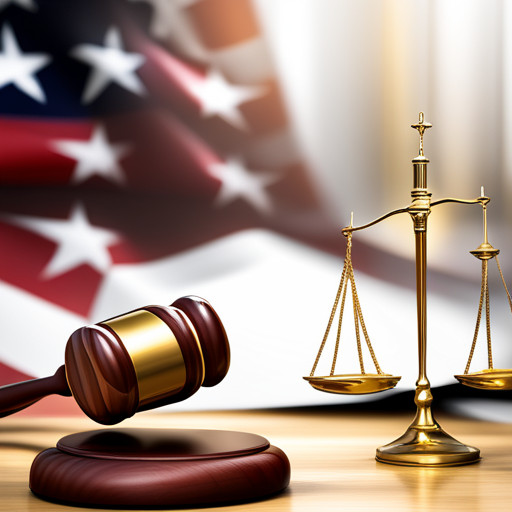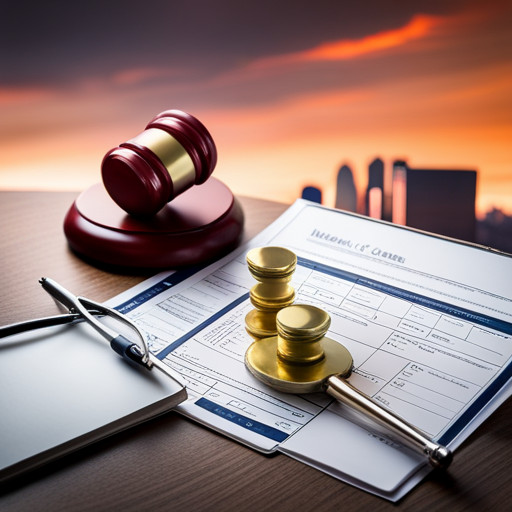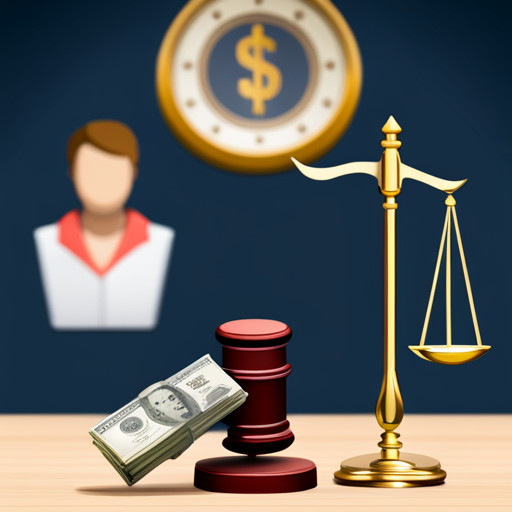Guide to Getting Fair Compensation for Nevada Car Accidents
Understanding the nuances of Nevada's car accident laws is crucial in securing fair compensation. This article provides a comprehensive guide to navigating through the aftermath of an accident, grasping fault and liability concepts, comprehending shared fault rules, and understanding relevant laws.

Additionally, it explores the role of reconstruction experts, litigation processes, and settlement negotiations. The ultimate aim is to equip readers with valuable knowledge that aids in achieving a just resolution post-accident.
Key Takeaways
- Stay at the scene, exchange information, and call 911 for help
- Seek prompt medical treatment and do not refuse or delay it
- Gather evidence from the accident scene and notify both insurance companies
- Understand Nevada's fault and liability rules, including the option to seek compensation from the at-fault driver and their insurance company
Understanding the Aftermath of a Car Accident

Understanding the aftermath of a car accident involves a series of crucial steps including remaining at the scene, exchanging information, seeking immediate medical attention, and promptly notifying the relevant insurance companies.
Equally important is the role of witnesses. Their accounts can validate the facts of the accident, providing an objective perspective that greatly influences the determination of liability.
Furthermore, the importance of police reports cannot be underestimated. These documents provide an authoritative summary of the accident, often including the attending officer's opinion on who was at fault. Thus, these reports can significantly influence the resolution of insurance claims and legal disputes.
Consequently, understanding these steps and the role of external parties, such as witnesses and police, is paramount for a fair resolution following a car accident.
Grasping the Concept of Fault and Liability in Nevada

In the realm of motor vehicle collisions in the Silver State, the concept of fault and liability plays a pivotal role in determining the outcome of insurance claims and lawsuits. Understanding fault allocation is crucial; Nevada employs the modified comparative fault rule. The compensation claim is reduced by the claimant's percentage of fault, provided they are not more at fault than the other party involved.
For proving liability, evidence from the accident scene is indispensable. Documentation of injuries and immediate medical attention substantiate the claim. The at-fault driver's negligent actions, such as disregarding traffic signals or failing to yield right of way, must be established.
In essence, the fault and liability paradigm in Nevada car accidents is predicated upon evidence, medical records, and the degree of negligence.
Insights Into Nevada’s Shared Fault Rules

Under the modified comparative fault rule, claims against the other driver may be pursued as long as the claimant is not more at fault, with compensation adjusted according to the percentage of fault attributed to the claimant. This rule, pivotal in understanding comparative negligence, highlights Nevada's approach to shared fault in vehicular accidents.
The implications of shared fault are significant as it can influence the amount of compensation received. If found partially at fault, the claimant's compensation is reduced proportionately. For instance, if the claimant is deemed 30% at fault, the compensation awarded is reduced by 30%. This rule ensures a fair distribution of liability, reflecting the extent of each party's negligence.
It underscores the importance of comprehensive accident investigations to establish accurate fault percentages.
The Path to Accident Compensation in Nevada

Navigating the aftermath of a vehicular mishap often includes potential eligibility for financial restitution, particularly if personal injuries are sustained. Understanding the claims process is crucial to ensuring rightful compensation. Key steps include:
1. Immediate reporting of the incident to relevant authorities, to establish an official record of the occurrence.
2. Seeking prompt medical attention, providing a crucial link between the accident and any injuries incurred.
3. Meticulous gathering and preservation of evidence, underscored by the importance of evidence in accident cases, which can significantly bolster claims.
In the state of Nevada, with its shared fault rules, the claimant's degree of fault is instrumental in determining the extent of compensation. Hence, the importance of comprehensive evidence cannot be overstated, as it can significantly impact the outcome of the claims process.
Comprehending the Laws Governing Car Accidents in Nevada

Comprehension of the regulations pertaining to vehicular collisions within the state is crucial for accident victims seeking redress. Understanding fault allocation, for instance, is integral to the process. Nevada follows a modified comparative fault rule, allowing victims to pursue claims if they bear less fault than the other driver. However, compensation is proportionately reduced by the victim's percentage of fault.
Eyewitness testimony can significantly influence the determination of fault. Independent third-party accounts of the accident often provide unbiased perspectives, strengthening the validity of claims.
| Nevada Accident Laws | Fault Allocation | Role of Eyewitness Testimony |
|---|---|---|
| At-Fault Liability State | Modified Comparative Fault | Provides unbiased perspectives |
| Optional Coverage | Compensation reduced by victim's fault percentage | Strengthens validity of claims |
| Insurers handle repair claims | Claims pursued if less at fault | Crucial in determining fault |
The Process of Claiming Insurance After a Car Accident

In the aftermath of comprehending the laws governing car accidents in Nevada, attention must now be directed towards understanding the process of claiming insurance post-accident. This process is critical as it determines the amount of compensation an affected party might receive.
The role of witnesses stands as an essential component in this process. Their testimonials can corroborate the victim's claims and provide an impartial perspective regarding the incident.
The importance of documentation cannot be overstated. This includes medical reports, repair bills, and photographic evidence which substantiate the extent of damage and injuries sustained.
Communication with the insurance company is the final step. This involves presenting the gathered evidence and negotiating a fair settlement based on the documented losses and the fault established.
Role of Medical Records in Car Accident Cases

Medical records play a pivotal role in substantiating claims in motor vehicle collision cases, as they provide tangible proof of injuries sustained and the subsequent treatments administered. These records, interpreted by medical experts, become essential pieces of evidence towards verifying the severity of injuries and correlating them to the accident. The role of medical experts is crucial, as they not only interpret the medical data but also provide professional opinions on the prognosis and potential future medical needs. Hence, the importance of collecting evidence, especially medical evidence, cannot be overstated.
| Importance of Medical Records | Role of Medical Experts |
| Validate injury claims | Interpret medical data |
| Indicate treatment administered | Give professional opinions |
| Correlate injuries to accident | Predict future medical needs |
Determining the Value of Your Car Accident Claim

Following the pivotal role of medical records in establishing the legitimacy of an injury claim, it becomes crucial to ascertain the value of the car accident claim. This process encompasses various factors including:
1. Medical Expenses: This entails the cost of immediate medical care post-accident as well as future medical costs for sustained injuries. Comprehensive documentation of these expenses significantly bolsters a claim.
2. Lost Wages: If an accident results in an inability to work, either temporarily or permanently, compensation for lost wages can be sought. Proof of income before and after the accident provides solid grounds for this claim.
3. Pain and Suffering: This includes physical pain and emotional distress. An expert testimony can substantiate these non-economic damages.
These elements combined define the monetary value of a car accident claim in Nevada.
Legal Assistance: When and Why You Need a Lawyer

Understanding the intricacies of accident liability and insurance claims often requires the expertise of a legal professional. Deciding when to hire such a professional involves an evaluation of the complexity of the case, the severity of the injuries, and the potential for significant compensation.
The benefits of legal representation extend beyond mere advocacy. A lawyer can provide clarity and guidance through the intricacies of Nevada's accident laws and insurance claims, ensuring a fair and just settlement. Additionally, legal professionals can negotiate with insurance companies, reducing the likelihood of an unfair dismissal or devaluation of the claim.
With a sound understanding of Nevada's comparative fault and liability rules, a lawyer can help clients navigate through the process and secure rightful compensation.
The Role of Car Accident Reconstruction Experts

Having discussed the necessity of legal assistance in navigating the complexities of accident claims, attention now shifts to the role of car accident reconstruction experts. These professionals provide invaluable contributions to the litigation process.
Expert Testimony: The importance of expert testimony cannot be emphasized enough. It lends credibility to the case, often swaying judgment in favor of the party presenting robust, scientifically-backed evidence.
Accident Scene Analysis: Reconstruction experts meticulously analyze accident scene data, deciphering the sequence of events leading up to the collision.
Objective Evaluation: Their impartial and scientific evaluation of the circumstances surrounding the accident assists in establishing fault.
Thus, the inclusion of a car accident reconstruction expert can greatly enhance the strength of a claim, ultimately aiding in achieving fair compensation.
Navigating Through the Litigation Process

Navigating through the litigation process entails several crucial steps, from the initial filing of the case to potential settlement discussions or trial proceedings. The process begins with car accident documentation, an imperative step that provides substantial evidence to support the case. In this phase, the importance of legal representation becomes evident, as a competent attorney can guide the plaintiff in the correct and lawful documentation of evidence.
The table below illustrates the general steps involved in the litigation process:
| Steps in Litigation | Description | Role of Legal Representation |
| :------------: | :------------: | :------------: |
| Case Filing | Initial step involving submission of legal documents | Guides in the preparation and filing of documents |
| Discovery | Both parties gather evidence | Helps in obtaining relevant evidence |
| Settlement Discussions | Parties negotiate to resolve the case | Ensures the best possible outcome for the client |
| Trial | Case is presented in court | Represents the client, argues the case |
| Judgment | The court makes a decision | Interprets the judgement, suggests further actions |
Thus, legal representation plays a vital role in navigating through the litigation process.
Settling a Car Accident Case Vs. Going to Trial

Determining whether to settle a motor vehicle collision case or proceed to trial requires a careful analysis of several factors. These factors include the strength of the case, the potential recovery amount, and the costs and risks associated with litigation.
1. Settling vs. Trial: A settlement provides a guaranteed compensation amount but may be lower than potential trial awards. Conversely, trials can yield higher awards but carry the risk of no compensation if the case is lost.
2. Strength of the Case: The degree of the other party's liability, the severity of injuries, and the clarity of evidence play crucial roles in deciding the course of action.
3. Importance of Evidence: Strong, compelling evidence can significantly influence the decision to settle or proceed to trial. Documentation of injuries, eyewitness testimonies, and accident scene photographs are invaluable in substantiating claims.
Tips for Negotiating a Fair Car Accident Settlement

Effective negotiation strategies for motor vehicle collision settlements include:
- Understanding the full extent of damages
- Maintaining clear and organized documentation
- Demonstrating patience during the process
In this negotiation process, the role of insurance adjusters is critical. They evaluate the claim, determine liability, and establish the amount of compensation. Thorough documentation plays a pivotal role in this procedure. It provides substantial evidence of the damages incurred and the expenses related to the accident. This can include medical reports, repair bills, and evidence of lost income.
Patience is also key, as hasty decisions can lead to unfavorable outcomes. Therefore, it is essential to await a fair offer that adequately addresses all damages before agreeing to a settlement.
Frequently Asked Questions
What Are Some Non-Monetary Damages I Could Claim in a Nevada Car Accident Lawsuit?”
In a Nevada car accident lawsuit, non-monetary damages may include intangible losses such as:
- Pain and suffering
- Emotional distress
- Loss of enjoyment of life
Additionally, loss of companionship, often claimed by spouses or close family members of an accident victim, may be sought. Consortium claims, typically pursued by a spouse, can also be included to compensate for the loss of familial relations or affection due to the accident.
In Nevada, How Is Pain and Suffering Calculated in a Car Accident Compensation?”
In Nevada, calculation of pain and suffering for car accident compensation encompasses both physical discomfort and emotional distress. This is often determined by a multiplier method, wherein the total of medical bills and lost earnings is multiplied by a certain factor, typically ranging from 1.5 to 5 based on severity.
The role of insurance is pivotal, as insurers may negotiate these multipliers within the policy limits and based on evidence of suffering.
Can I Claim Damages for Emotional Distress Caused by a Car Accident in Nevada?”
In Nevada, it is indeed possible to claim damages for emotional distress caused by a car accident. Under Nevada's distress laws, compensation can be sought for emotional trauma.
However, it is important to provide substantial proof of emotional distress. This could include medical records, psychological evaluations, or testimony from mental health professionals.
The severity of emotional trauma and its impact on the individual's life are considered during compensation calculations.
How Can a Previous Injury Impact My Car Accident Claim in Nevada?”
In Nevada, a pre-existing condition can influence a car accident claim significantly. Full disclosure of such injuries is a critical strategy in these cases. If undisclosed, insurance companies may deny claims or reduce settlement amounts, arguing that the injuries were not caused by the accident.
However, if a pre-existing condition is exacerbated by the accident, the claimant may be entitled to compensation for the aggravation of the injury.
What Are the Implications if the At-Fault Driver in a Nevada Car Accident Is Uninsured or Underinsured?”
In Nevada, if an at-fault driver is uninsured or underinsured, implications exist for both parties involved. The uninsured driver may face legal penalties, while the victim may confront difficulties in obtaining due compensation.
However, victims can seek redress through their own insurance policy's uninsured/underinsured motorist coverage, subject to policy limitations. Uninsured consequences and policy limitations thus underscore the importance of comprehensive insurance coverage in protecting against potential financial burdens following a car accident.

This post has been generated by AI and was not reviewed by editors. This is Not legal advice. Please consult with an attorney.




